
American Motors Corporation was an American automobile manufacturing company formed by the merger of Nash-Kelvinator Corporation and Hudson Motor Car Company on May 1, 1954. At the time, it was the largest corporate merger in U.S. history.
Rambler is an automobile brand name that was first used by the Thomas B. Jeffery Company between 1900 and 1914.
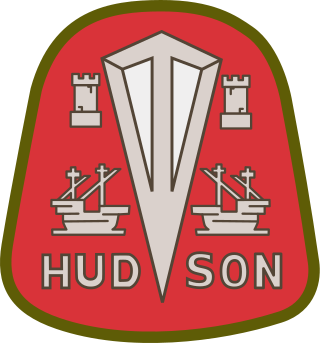
The Hudson Motor Car Company made Hudson and other branded automobiles in Detroit, Michigan, U.S., from 1909 until 1954. In 1954, Hudson merged with Nash-Kelvinator to form American Motors Corporation (AMC). The Hudson name was continued through the 1957 model year, after which it was discontinued.

The Ambassador is an automobile manufactured and marketed by American Motors Corporation (AMC) from 1957 through 1974 over eight generations, available in two- and four-door sedan, two-door hardtop, four-door station wagon as well as two-door convertible body styles. It was classified as a full-size car from 1957 through 1961, mid-size from 1962 until 1966, and again full-size from 1967 through 1974 model years.
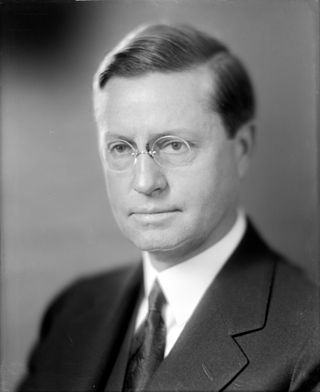
Roy Dikeman Chapin Sr. was an American industrialist and a co-founder of Hudson Motor Company, the predecessor of American Motors Corporation. He also served as the United States secretary of commerce from August 8, 1932, to March 3, 1933, during the final months of the administration of President Herbert Hoover.
Nash-Kelvinator Corporation was the result of a merger in 1937 between Nash Motors and Kelvinator Appliance Company. The union of these two companies was brought about as a result of a condition made by George W. Mason prior to his appointment as CEO of Nash. The company manufactured cars and refrigerators as well as aeronautic components and helicopters during World War II. In 1954, the company merged with Husdon Motors to form American Motors Corporation (AMC).

Richard Arthur Teague was an American industrial designer in the North American automotive industry. He held automotive design positions at General Motors, Packard, and Chrysler before becoming Vice President of Design for American Motors Corporation (AMC), and designed several notable show cars and production vehicles including AMC's Pacer, Gremlin, and Hornet models, as well as the Jeep Cherokee XJ and either designed or assisted in the designing of later cars for Chrysler such as the Jeep Grand Cherokee and Neon after American Motors' buyout.
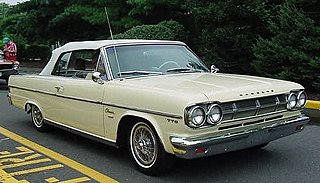
The Rambler Classic is an intermediate sized automobile that was built and sold by American Motors Corporation (AMC) from the 1961 through 1966 model years. The Classic took the place of the Rambler Six and Rambler Rebel V-8 names, which were retired at the end of the 1960 model year.

The Hudson Jet is a compact automobile that was produced by the Hudson Motor Car Company of Detroit, Michigan, during the 1953 and 1954 model years. The Jet was the automaker's response to the popular Nash Rambler and the costs of developing and marketing the Jet ultimately led to Hudson's merger with Nash.

Roy Dikeman Chapin Jr. was the chairman and chief executive officer of American Motors Corporation (AMC). Chapin's father, Roy D. Chapin Sr., was one of the co-founders of the Hudson Motor Car Company; Hudson later merged with Nash-Kelvinator Corporation in 1954 to form American Motors. Roy D. Chapin Jr. was instrumental in introducing many successful lines of cars by American Motors that included the Gremlin, Hornet, and Javelin, as well as the purchase of Kaiser Jeep by the automaker.

The Hudson Greater Eight is a luxury car that was produced by the Hudson Motor Car Company of Detroit, Michigan during 1931 and 1932.
Gerald Carl Meyers was an American industrialist, author, lecturer, and management consultant who was chairman and CEO of American Motors Corporation (AMC) from 1977 to 1982.

Abraham Edward Barit was an American industrialist who served as the president and CEO of the Hudson Motor Car Company from 1936 to 1954 when Hudson merged with Nash Motors to form American Motors Corporation. Barit served on the board of AMC following the merger of the two automakers.
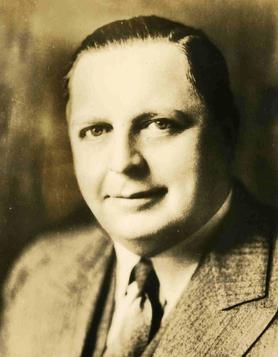
George Walter Mason was an American industrialist. During his career Mason served as the Chairman and CEO of the Kelvinator Corporation (1928-1937), Chairman and CEO of the Nash-Kelvinator Corporation (1937-1954), and Chairman and CEO of American Motors Corporation (1954).

Roy Abernethy was an executive in the American automobile industry, serving as CEO of American Motors Corporation (AMC) from February 1962 to January 1967. Prior to his tenure at AMC, Abernethy had been with Packard Motors and Willys-Overland. Abernethy replaced George W. Romney, who resigned from AMC to become Governor of Michigan.
Edmund E. Anderson was an automotive designer in the North American automotive industry at General Motors and notably as the lead designer for American Motors Corporation (AMC) from 1950 to 1961.

The Rambler Six and the Rambler V8 are intermediate sized automobiles that were built and marketed by American Motors Corporation (AMC) from 1956 to 1960.

Robert Beverley Evans Sr. was an automobile industry executive, a prominent Republican, an industrialist, a socialite, and an avid sportsperson. He founded Evans Industries. Evans also became chairman of American Motors Corporation (AMC).
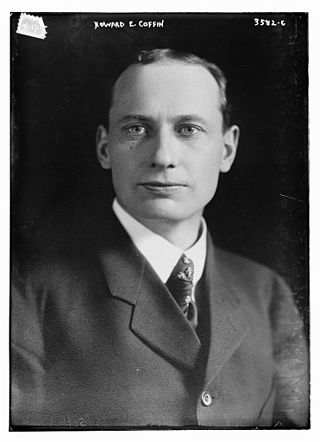
Howard Earle Coffin was an American automobile engineer and industrialist. He was one of the founders of the Hudson Motor Car Company with Roy D. Chapin. He was a charter member of The Society of Automotive Engineers and president in 1910, and as one of the "dollar-a-year men" served as chairman of the Aircraft Board which organized aircraft production and industrial mobilization during World War I. He retired from the Hudson company in 1930 but acted as a consultant. He died accidentally in 1937.

The Jeffery Quad, also known as the Nash Quad or Quad is a four-wheel drive, 11⁄2-ton rated truck that was developed and built by the Thomas B. Jeffery Company from 1913 in Kenosha, Wisconsin, and after 1916 by Nash Motors, which acquired the Jeffery Company. Production of the Quad continued unchanged through 1928.

















